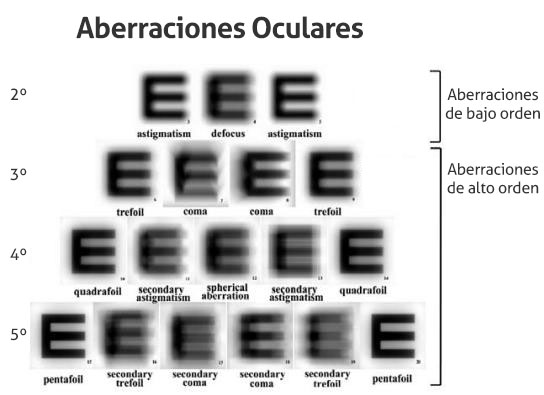A lot of patients are unaware of higher order aberrations, they can be more subtle but they also affect vision. We tend to talk more about myopia, hyperopia or astigmatism which are lower order aberrations because they affect vision more.
Higher order ocular aberrations are other more complex imperfections that affect the quality of the image projected by the cornea onto the retina, and as a result one may have less clear vision. The good thing is that current technology allows us to detect and treat them.
High order aberrations or higher order
The patient should know that there are usually several aberrations at the same time and in both eyes. By means of customized treatments in Vistalaser Oftalmologia we can improve aspects such as the quality of night vision, the ability to differentiate shades in different colours and brightness, and the resistance to glare.
The symptoms of higher order aberrations can be varied. Some patients describe them as double vision sensation, halos, loss of contrast especially at night, blurred vision, lack of clarity, blurred edges of letters and poor detail, glare, and poor night vision.
To understand these eye aberrations a little better, we can comment on some of them, although many more are known:
- Trefoil aberration, is a triangular astigmatism with three axes. This higher order aberration causes the patient to suffer from glare and halos around objects. For example, one point could be seen as the Mercedes star due to the halos.
- The Coma Aberration is a higher order aberration which is called this because a point is seen with a tail. That is, it is similar in shape to an orthographic coma or a comet. This visual problem occurs in patients with keratoconus, in refractive treatments of off-centre ablations or inclined or out-of-position intraocular lenses. One perceives it as double vision, halos and glare around objects, affecting both the contour and the corners of the images.
- Spherical aberration is a problem linked to the natural shape of the eye, and everyone suffers from it to a greater or lesser degree. This defect prevents peripheral light rays from focusing on the retina, resulting in blurred and halosed vision. In low light we perceive the shape and details of objects less well. It therefore affects driving at night, in cinemas and in rain or snow.
The problems that Refractive Surgery corrects
High order aberrations can affect the patient’s vision by up to 15%. Their effect is most evident in pupils of larger diameter. Their most effective treatment is achieved with wavefront technology. It has been available for years in the Vistalaser clinics in Malaga, Marbella and Granada.
Currently, solutions like contact lenses do not correct all high-order aberrations. Refractive surgery techniques like conventional LASIK can even make them worse. To achieve the best possible result, it is advisable to carry out a personalised treatment with the help of an aberrometer. This device creates a detailed map of the cornea where all the defects are reflected which the laser will subsequently correct.
Myopia, hypermetropia and astigmatism are problems that Refractive Surgery corrects, but technological advances have given rise to more complete equipment and we are now able to correct visual problems in the same treatment that glasses and contact lenses are unable to correct.
At Vistalaser Oftalmologia we offer wavefront-guided treatments, a procedure that goes beyond conventional Refractive Surgery, as it is capable of correcting more subtle and complex optical errors, which are called higher order aberrations, such as those mentioned: trefoil, coma, or spherical.
Although the latter represent a small part of your refractive problem, it is clear that correcting high order aberrations, in addition to low order ones, will provide you with an improvement in the quality of night vision, the ability to difference shades in colours and brightness and resistance to glare.


Leave A Comment